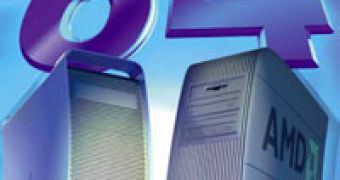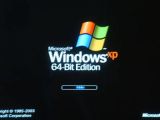64-bit computing is coming faster in the world of desktop PCs. Intel, AMD and Microsoft are leading the way and this time around it (unlike some years ago when a home dedicated computer system running Windows on 64-bit Alpha processor has failed) seems that nobody can stop the migration to 64-bit systems for home use.
The 64-bit computing is embraced by the computing industry like it is about a new Mecca and the news about some new processors, applications and operating systems which can take advantages of this feature are coming everyday from all around the world.
OK, the 64-bit is a big step ahead, but what about the final users? Will they really benefit from this new technology or is just another marketing boom meant to sell some more million units from a new generation of computers, at new prices? Is the 64-bit computing really a necessity for the user for which the main purpose of PC is surfing on the Net and processing Word documents? Before answering to all this questions and many others, let's first take a long at the recent history of the 64 bits computing.
Before the dawn of 64 bit
Looking at all that excitement which is surrounding every piece of information about new breakthroughs in the world of 64-bit, an inexperienced user may think that this technology is the latest hot news. In reality, things are a little bit different.
Long, long ago, before our time, (to be more specific before in the '80's) the computer systems jumped from 8 bit to 16 bit. Later on, in the early 90's, the systems jumped once again, to 32 bit.
From then the 32 bit architecture become the common place for all the computers for end-users. As you can see, the 32 bit platform is already two decades old and is surprisingly that it resisted so long.
FIRST COMERCIAL BREAK
But what means all this stuff with 8 bit, 16 bit, 32 bit or 64 bit and why is important ?
32-bit refers to the number of bits (the smallest unit of information on a machine) that can be processed or transmitted in parallel, or the number of bits used for single element in a data format.
When used in conjunction with a microprocessor, the term indicates the width of the registers; (for those of you that don't know what registers means, here is the explanation ). A 32-bit microprocessor can process data and memory addresses that are represented by 32 bits.
Therefore, 64-bit refers to a processor with registers that store 64-bit numbers. A generalization would be to suggest that 64-bit architecture would double the amount of data a CPU can process per clock cycle.
END OF THE FIRST COMMERCIAL BREAK
In this two decades, the computing environment has evolved to new applications, (and we are talking especially about video editing and gaming), to larger databases, to complex 3D simulations, and the computing power of 32-bit cannot face the performance required for this.
Why the need for 64-bit?
All the talk about 64 bit and 64 bit processors may make one think that is about a double speed for processors. No, it's not about speed, in the first place is about memory.
A computer with a 32 bit processor can use up to 4 GB of RAM (only with a capable motherboard) which is split between the applications and the operating system (OS): 2 GB for applications and 2 GB for OS.
One of the most attractive features of 64-bit processors is the amount of memory the system can support. 64-bit architecture will allow systems to address up to one terabyte (1000GB) of memory. (But as far as I know, nobody in the memory business has declared that has begun to work on greater than 1 GB DIMM, so all the end users will see, it will be probably 8 GB of RAM on their 64-bit computers)
That is the main reason why many companies and organizations that access huge amounts of data have already made the transition to 64-bit servers, since they can support a greater number of larger files and could efficiently load large enterprise databases into memory resulting in faster searches and data retrieval.
Think about Google or E-bay, or even at a company that is involved in selling tickets over the Web, and try to imagine how the database needed to run those delightful sites looks.
Additionally, using a 64-bit server means organizations can support more simultaneous users on each server - potentially removing the need for extra hardware as one such server could replace the use of several 32-bit servers on a network.
64 bit computing is already 10 years old, but it was reserved only for major companies and only two years ago the first desktop processor on 64 bit has become a mainstream trend.
AMD - the leader of the leaders of 64-bit
September 2003: this is a date to remember. The first Athlon64 has hit the desktop processors market and ever since the race begun. But?wait that's not all.
SECOND COMMERCIAL BREAK
Most 64-bit CPU benefits will go unnoticed without the key components of a 64-bit operating system and 64-bit software and drivers that can take advantage of 64-bit processor features. For the average computer user, 32-bit is more than enough computing power. Athlon64 was the first, but speaking about OS for desktop, all the looks go to Windows.
Without a 64-bit Windows all the investment in the development of new desktop 64 bit processors is just a beautiful story for Linux and Apple users (Both Linux and Apple already have OS versions for 64-bit processors)
So a Windows 64-bit is needed. The answer from Microsoft was a never ending dance.
AMD has been pushing hard for a 64-bit Windows operating system. But each time a launch date for Windows XP Professional x64 Edition was announced, Gates remembered all kind of things: the work on security issues (and God knows that there is a lot of work to be done), then launching XP SP2.
On the other hand, Intel position was very clear: we don't have a mainstream OS for 64-bit desktop, so we don't need a processor. So, all the blame goes to Microsoft, because later on Intel has said they are able in any moment to launch a 64-bit processor, but where is the OS?
END OF SECOND COMMERCIAL BREAK
In the lack of 64-bit applications and a properly OS, Athlon64 seemed to become just another great failure. Only, the "newcomer outsider" has proved that he is able to run even in a 32-bit environment faster then a dedicated 32-bit processor. AMD has put all his money on the new line and continues to lead the way with Athlon 64 processors appearing in both desktops and notebooks. In fact, AMD announced plans for a next-generation 64-bit notebook processor called Turion.
"What!! There is a new desktop processor who is taking all the glory, and its name is not based on the magic word "Pentium"?" asked Intel. "This is impossible"
And at the very beginning of 2005, Intel says it will have a new generation of 64-bit-ready Pentium 4 processors before midyear as well. On the other hand, Microsoft has released its first x64 release candidate and promises to launch the final product by April.
IMPORTANT COMMERCIAL BREAK
All the conspiracy theory of Microsoft backing up Intel, is only in your head, you almighty reader! I am just telling the facts.
END OF COMMERCIAL BREAK
The end user world of 64-bit
So?in 2005 it seems that all the pieces of the puzzle had come in one place. We have 64-bit OS, 64-bit processors (from Intel and AMD), even some applications, so we are ready for the big migration.
But?and here comes the bad news. If you think, as end user which think to migrate to 64-bit computing, that the browser will be moving faster, your Word documents will take a fly or the Powerpoint documents will look flashier, you will be disappointed.
But?and here comes the good news you will see the benefits in more demanding applications such as video encoding, gaming and everything that is requiring more memory. Already there are some applications.
By example, NewTek says it will port its LightWave 3D graphics and visual effects package to X64 OS this year. Epic Games has pledged to release a 64-bit version of its Unreal Tournament 2004.
The main software developers, as Adobe, Corel or even Microsoft, hasn't announced versions of their programs for 64-bit, but it is just a matter of time. Even now, there are rumors that an MS Office 64-bit it will be available in 2006.
Even the Windows 64-bit it will be soon available, migrating as end user, from 32-bit to 64-bit is still a problem. Hardware drivers for Windows XP 64-bit are not available from all the major producers; even Microsoft has requested those kinds of drivers.
Judging from all this aspects it seems the 2006 will be the year of the next Major Desktop Migration 64-bit. We have to wait just a little bit more! And, since I will write my articles on my new desktop powered by a Zillion MB of RAM, I wish you all: Good computing and take care!
64-BIT DESKTOP TIMELINE
AMD Athlon 64 desktop CPUs (September 2003) Windows XP Professional X64 Edition (Spring 2005) Intel X64 Pentium 4 (Spring 2005) AMD Turion second-generation 64-bit notebook CPUs (Spring 2005) Longhorn X64 (2006)
*I would like to address my thanks to one of SOFTPEDIA users, "rathor", for his comments, that were the starting point of this story!

 14 DAY TRIAL //
14 DAY TRIAL // 

